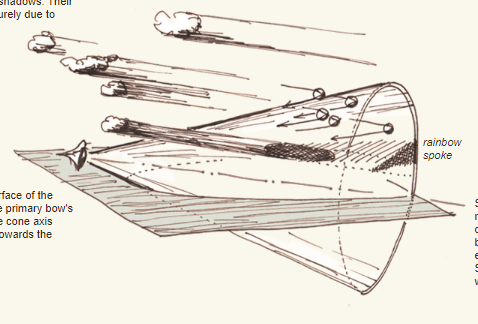Rainbow & Antisolar Rays - OPOD
Rainbow & Antisolar Rays - Exploring the Phenomenon
Rainbows and antisolar rays are captivating atmospheric optical phenomena that have fascinated humans for centuries. In this article, we will delve into the intricacies of these awe-inspiring natural displays and unravel the science behind their formation.
The Antisolar Rays
Antisolar rays, also known as anticrepuscular rays, are a mesmerizing phenomenon created by long parallel shadows cast by clouds with a bright sky between them. These rays appear to converge towards a point known as the antisolar point, which is purely an illusion caused by perspective. The convergence of the rays adds to their dramatic allure, drawing our gaze towards the center of the phenomenon.
The Rainbow Bridge
A primary rainbow is a primary feature of the rainbow and antisolar ray spectacle. It forms a radiant arch that seemingly bridges the sky, often spanning across bodies of water like rivers. The primary rainbow is accompanied by fragments of an outer reverse color secondary bow, creating a visually stunning contrast against the dark sky between the bows, commonly referred to as Alexander's dark band.
The Rainbow Cone
To understand the formation of the primary rainbow, we need to explore the concept of the "rainbow cone." This cone extends from the observer's eye towards the antisolar point, encompassing raindrops near the surface. It is within this cone that the outer colored rim of the primary bow is formed by raindrops.
Intersecting Cloud Shadows
In some instances, the beauty of the primary rainbow may be interrupted by intersecting cloud shadows. When a cloud shadow intersects the rainbow cone, raindrops within the shadow cannot contribute to the formation of the rainbow. This results in a portion of the bow being obscured, giving rise to a dark "spoke" that extends inwards towards the center of the bow. Multiple cloud shadows and spokes can create a mesmerizing wheel-like pattern that often rotates as the clouds move.
The Ever-Changing Nature
One of the fascinating aspects of rainbow and antisolar ray phenomena is their ever-changing nature. As the position and density of clouds shift, the appearance of the rainbow and antisolar rays can transform dynamically. This constant evolution adds an element of unpredictability to these natural wonders, leaving us in awe of the wonders of our atmosphere.
Atmospheric Optics Delights
Rainbows and antisolar rays are just a few examples of the breathtaking displays that fall under the realm of atmospheric optics. From halos and sundogs to iridescent clouds and crepuscular rays, our atmosphere is a canvas for an array of optical marvels. Exploring these phenomena not only deepens our understanding of the science behind them but also allows us to appreciate the beauty and complexity of our natural world.
In conclusion, rainbows and antisolar rays are awe-inspiring atmospheric optical phenomena that captivate our senses and ignite our curiosity. The convergence of antisolar rays, the bridge of the primary rainbow, and the interplay of cloud shadows all contribute to the enchanting spectacle. By exploring these phenomena, we gain a deeper appreciation for the wonders of our atmosphere and the intricate mechanisms that give rise to such breathtaking displays. So, next time you witness a rainbow or catch a glimpse of antisolar rays, take a moment to marvel at the intricate beauty of our natural world.

Rainbows & Antisolar Rays
Image by J�rg Alean (Swisseduc.ch, Stromboli online) over the Rhine at Eglisau, Switzerland.
©J�rg Alean, shown with permission
Long parallel shadows cast by clouds with bright sky between them generate the antisolar (anticrepuscular) rays and shadows. Their apparent convergence is purely due to perspective.
A bright primary rainbow bridges the Rhine with fragments of an outer reverse colour secondary bow. The sky is dark between the bows - Alexanders dark band.
Dramatic antisolar rays and shadows converge down towards the rainbow centre, the antisolar point. At left the shadows form rainbow spokes.

Raindrops near the surface of the 'rainbow cone' form the primary bow's outer coloured rim. The cone axis extends from the eye towards the antisolar point.
Sometimes a cloud shadow intersects the rainbow cone. Raindrops within the shadow cannot contribute to the rainbow. Part of the bow is blotted out and a dark 'spoke' can extend inwards towards the bow centre. Several clouds and spokes make a wheel which often revolves as the clouds move.
Note: this article has been automatically converted from the old site and may not appear as intended. You can find the original article here.
Reference Atmospheric Optics
If you use any of the definitions, information, or data presented on Atmospheric Optics, please copy the link or reference below to properly credit us as the reference source. Thank you!
-
<a href="https://atoptics.co.uk/blog/rainbow-antisolar-rays-opod/">Rainbow & Antisolar Rays - OPOD</a>
-
"Rainbow & Antisolar Rays - OPOD". Atmospheric Optics. Accessed on November 26, 2024. https://atoptics.co.uk/blog/rainbow-antisolar-rays-opod/.
-
"Rainbow & Antisolar Rays - OPOD". Atmospheric Optics, https://atoptics.co.uk/blog/rainbow-antisolar-rays-opod/. Accessed 26 November, 2024
-
Rainbow & Antisolar Rays - OPOD. Atmospheric Optics. Retrieved from https://atoptics.co.uk/blog/rainbow-antisolar-rays-opod/.